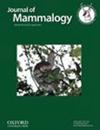Two new species of brush-tailed mouse, genus Calomyscus (Rodentia: Calomyscidae), from the Iranian Plateau
IF 1.5
3区 生物学
Q2 ZOOLOGY
引用次数: 0
Abstract
The monogeneric family Calomyscidae includes the brush-tailed mice, genus Calomyscus, which have a Palearctic distribution ranging from the Hindu Kush Mountains in western Pakistan to the eastern Mediterranean region. Zagros Mountains—stretching from northwest to south of Iran—was assumed for long as the range of a single species, Calomyscus bailwardi; however, recent studies revealed considerable heterogeneities among the geographical populations presumably referring to the persistence of undescribed diversity. One such group from the western Zagros Mountains has recently been recognized as C. behzadi Akbarirad, Dezhman, Aliabadian, Siahsarvie, Shafaeipour, and Mirshamsi, 2021. Using molecular, morphometric, geometric morphometric, and karyotypic data, we examine the divergence of 2 additional groups from western Iran and name these as new species. The first of these species is distributed in the northern Zagros and western Alborz Mountains in northwestern Iran was recovered as the sister species to C. urartensis from the South Caucuses. The second species from a single locality in the central Zagros Mountains was clustered closely with C. grandis from the western Alborz Mountains. Morphologic analyses, karyological features, and genetic distances disentangled these 2 new species from their sister species.来自伊朗高原的两个刷尾鼠新种(啮齿目:刷尾鼠属
刷尾鼠科(Calomyscidae)包括刷尾鼠属,分布于古北区,从巴基斯坦西部的兴都库什山脉到地中海东部地区。扎格罗斯山脉从伊朗的西北部延伸到南部,长期以来一直被认为是一个物种(Calomyscus bailwardi)的分布区;然而,最近的研究发现,这些地区的种群之间存在相当大的异质性,这可能是由于未描述的多样性持续存在。其中一个来自扎格罗斯山脉西部的种群最近被确认为 C. behzadi Akbarirad、Dezhman、Aliabadian、Siahsarvie、Shafaeipour 和 Mirshamsi,2021 年。利用分子、形态、几何形态和核型数据,我们研究了伊朗西部另外两个类群的分化情况,并将其命名为新种。其中第一个物种分布于伊朗西北部的扎格罗斯山脉北部和阿尔伯兹山脉西部,被认为是南高加索地区 C. urartensis 的姊妹种。第二个物种来自扎格罗斯山脉中部的一个地点,与阿尔伯兹山脉西部的 C. grandis 紧密聚类。形态学分析、核果学特征和遗传距离将这两个新物种与其姊妹物种区分开来。
本文章由计算机程序翻译,如有差异,请以英文原文为准。
求助全文
约1分钟内获得全文
求助全文
来源期刊

Journal of Mammalogy
生物-动物学
CiteScore
3.30
自引率
5.90%
发文量
106
审稿时长
4-8 weeks
期刊介绍:
Papers are published on mammalian behavior, conservation, ecology, genetics, morphology, physiology, and taxonomy.
 求助内容:
求助内容: 应助结果提醒方式:
应助结果提醒方式:


